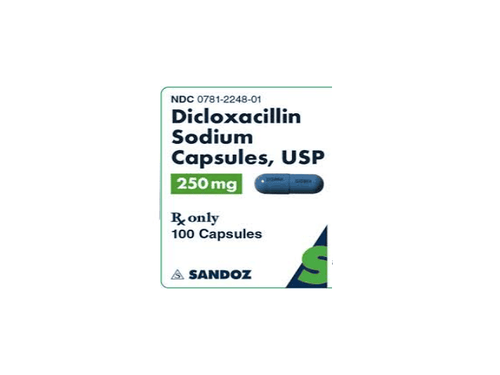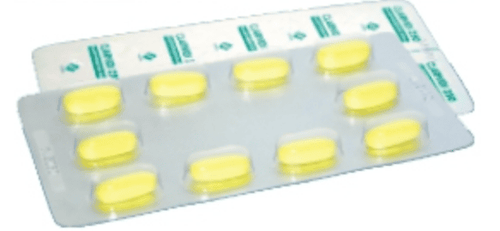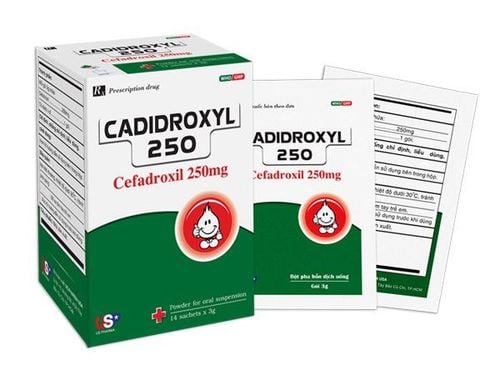This is an automatically translated article.
What is Cophadroxil, is it an antibiotic? With the main ingredient Cefadroxil, Cophadroxil is a first-generation cephalosporin antibiotic that kills some pathogenic bacteria in the respiratory tract, urinary tract, bone marrow, skin and subcutaneous.
1. What is Cophadroxil?
Cophadroxil belongs to the group of drugs to treat parasites, infections, viruses and fungi, with the main ingredient being Cefadroxil monohydrate corresponding to Cefadroxil, content 500mg. Cefadroxil is a first-generation cephalosporin antibiotic with a moderate antibacterial spectrum. Cefadroxil is effective against gram-positive (staph, streptococci, pneumococcal) and gram-negative (E.coli, Proteus mirabilis, Klebsiella pneumoniae, Shigella) bacteria. The mechanism of action of Cefadroxil in Cophadroxil is to inhibit bacterial cell wall synthesis, kill bacteria by inhibiting the final stage of cell wall synthesis, leaving bacteria defenseless. .Cophadroxil drug is made in the form of capsules and is indicated for the treatment of the following cases:
Respiratory tract infections such as otitis media, laryngitis, pharyngitis, tonsillitis, acute and chronic bronchitis , lobar pneumonia, pleurisy, empyema, lung abscess. Urinary tract infections such as nephritis, cystitis, acute and chronic pyelonephritis, urethritis. Skin and subcutaneous soft tissue infections such as lymphadenitis, cellulitis, abscess, ulcer. Infectious arthritis, osteomyelitis.
2. Usage and dosage of Cophadroxil
Cophadroxil is taken orally, taking the drug with water. The recommended dosage in adults and children is as follows:
Adults: 500mg - 1g/time, taken 1-2 times/day depending on the degree of infection. Children over 6 years old: 500mg/time, 2 times/day. Children under 6 years old: 250mg/time, 2 times/day. Elderly, patients with renal failure: Adjust dose. Cophadroxil overdose can cause symptoms such as nausea, vomiting, diarrhea, convulsions in patients with renal failure. In case of overdose, the patient should be treated supportively or symptomatically with gastro-intestinal lavage.
It is necessary to determine the cause of the above symptoms to have appropriate treatment, because it is easy to confuse with side effects, drug interactions or overdose of other drugs.
3. Cophadroxil side effects
Cophadroxil can cause some unwanted side effects with the frequency of occurrence as follows:
Common: Nausea, abdominal pain, diarrhea. However, most of these symptoms are mild. Uncommon: Urticaria, pruritus, vaginitis, testicular pain, genital pruritus. Rare: Gastrointestinal disturbances, fever, anaphylactoid reactions, convulsions, leukopenia and thrombocytopenia, jaundice, hepatitis, ... If there are any manifestations after taking Cophadroxil, people Patients should immediately report to the doctor or soon go to a medical facility for a health check.
4. Some notes when using Cophadroxil drug
Do not use Cophadroxil in people with hypersensitivity to any of the drugs or antibiotics of the Cephalosporin group. People with Penicillin allergy, digestive disease, kidney failure need to be careful when using Cophadroxil. People with liver disease should only take the drug when prescribed by a doctor. Long-term use of Cephalosporin antibiotics can cause superinfection and the patient needs to stop taking the drug. Women who are pregnant or breastfeeding should not take Cophadroxil because information on its safety is limited. People with heart disease need to be careful when taking Cophadroxil because the drug can increase the concentration of creatinine in the blood. Concomitant administration of Cophadroxil with Cholestyramine may delay the absorption of the drug, with Probenecid may reduce drug excretion, with Aminoglycosides and Furocemide may increase nephrotoxicity, with drugs or preparations containing potassium may cause increased potassium levels in the blood. To avoid interactions between Cophadroxil with other drugs, patients need to inform their doctors about all medications they have been taking, including herbs and supplements. In summary, the use of Cophadroxil is to treat infections in the respiratory tract, urinary tract, skin and joints by killing pathogenic bacteria. To ensure safety for your health and maximize the effectiveness of your treatment, you need to take Cophadroxil exactly as directed by your doctor.













